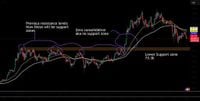The S&P 500's recent breakdown below key technical levels suggests the market’s counter-trend rally may be over, said Jonathan Krinsky, chief market technician at financial-services firm BTIG. In a March 28 note to clients, Krinsky pointed to the S&P 500's struggles as indicative of a potential shift in market momentum.
Meanwhile, Bitcoin (BTC) has faced its own challenges, with its price slipping 7% from a high of $88,060 on March 26 to $82,036 by March 29. This downturn wiped out $158 million in long liquidations, underscoring the fragility of both spot and derivatives markets. As Bitcoin falters, gold has surged to a record $3,087 on March 28, further complicating the cryptocurrency’s narrative as “digital gold.”
Koroush AK, a trader and researcher, described Bitcoin's recent rally as a "dead cat bounce," noting that the cryptocurrency failed to close above $90,000 for five consecutive days. He stated on March 28, "Price failed to reach $90K this week after trying for 5 days in a row." This sentiment reflects a growing concern among traders about Bitcoin's ability to maintain upward momentum amid increasing market pressures.
Adding to the bearish tone, long-term holders of Bitcoin have paused their accumulation efforts since November 2024, according to market analyst Ali. He noted on March 30, "Long-term #Bitcoin $BTC holders have been on pause since November 2024…Their return could mark a major trend shift." This inactivity among long-term holders, coupled with declining exchange inflows, suggests reduced investor participation in the market.
Analysts are now highlighting bearish targets for Bitcoin as macroeconomic conditions worsen. Altcoin Sherpa characterized the current structure on the weekly chart as indicative of a confirmed bear market, suggesting that the price could fall to the $50,000–$60,000 range, depending on how these conditions evolve. In an update on March 29, he remarked, "We see periods of chop but still a bearish trend."
Crypto Capo echoed this outlook, stating that Bitcoin remains at risk of falling to $62,000. He emphasized that a close below the $84,000–$85,000 range would likely trigger capitulation toward support levels established in April and November 2024.
On March 28, Bitcoin spot exchange-traded funds (ETFs) recorded $93 million in net outflows, a development that coincided with rising fears of a recession and delayed rate cuts by the U.S. Federal Reserve. The CME FedWatch tool indicates a 50% chance of interest rates dropping below 4% by July 30, up from 46% a month earlier. While easing could benefit risk assets, the recent ETF flows suggest that large players remain cautious about entering the market.
Despite the U.S. dollar index (DXY) dropping to 104 from 107.4 a month prior, Bitcoin has struggled to capitalize on this trend, diverging from the historical pattern where a weaker dollar tends to boost cryptocurrency prices. Mihaimihale, a market commentator on X, suggested that the U.S. government may introduce tax cuts and lower interest rates to offset slowing growth. However, he cautioned that last year’s expansion was largely driven by government spending, which is unlikely to be replicated.
In a more optimistic vein, Alexandre Vasarhelyi, founding partner at B2V Crypto, remarked that Bitcoin remains in its adoption phase, with volatility reflecting early-stage growth. He stated, "Whether Bitcoin’s floor is $77,000 or $65,000 matters little…2025 is still a foundation year, not a tipping point." This perspective suggests that while current market conditions may be challenging, they could also present opportunities for future growth.
As traders eye $62,000 as the next major support level, the combination of inactive long-term holders and rising macro pressures raises the odds of a further breakdown in Bitcoin's price. However, any renewed buying from long-term holders or a dovish shift in central bank policy could alter this outlook and potentially stabilize the market.






